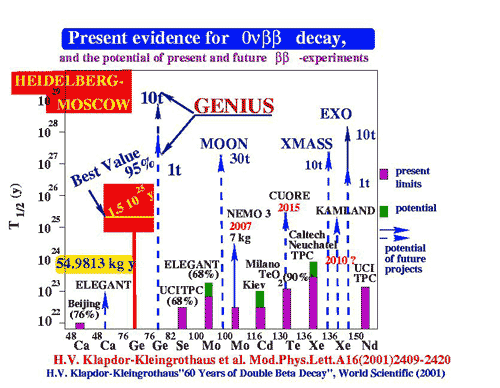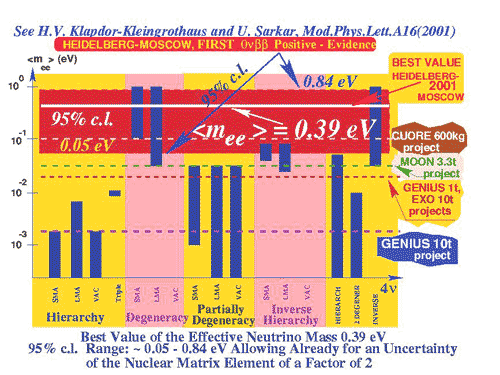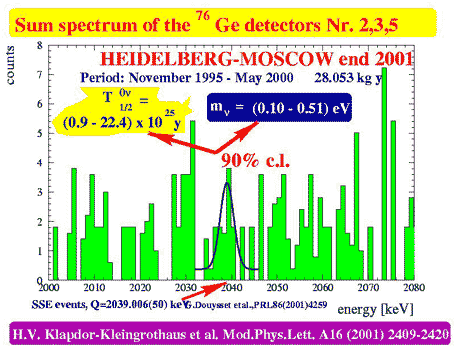The realization of the experiment goes back to first discussions in 1986
about a cooperation between Max Planck Institut für Kernphysik, Heidelberg,
Leningrad Institute of Nuclear Physics, Gatchina, and Kurchatov Institute,
Moscow. The first public announcement of the idea was made at the first WEIN
conference in Heidelberg 1986, held
on the occasion of the {\bf 600th} anniversary of the University of Heidelberg.
Later conferences of this series at Montreal, Dubna, Osaka and Santa Fe, WEIN98,
USA, provided centers of active discussions of among others double beta decay
and related particle physics. A proposal of the experiment was presented at
the MPI Heidelberg in 1987 (H.V.
Klapdor, MPI- Report 1987-V 17). In the early time we also tried to include
French colleagues from Bordeaux into a collaboration. The search for suitable
sites for the experiment included at that time Baksan (Kaukasus), Solotvina
(Ukraine), Gran Sasso (Italy) and Frejus (France). On the basis of exploratory
research of the different parties on the optimal background, the decision was
finally made to use the shielding suggested and built
by the Heidelberg group, and to locate the experiment in
the Gran Sasso Underground Laboratory (LNGS) ,
and the collaboration between MPI Heidelberg and Kurchatov Institute, Moscow
was formed. The president of the Istituto Nazionale di Fisica Nucleare (INFN),
at that time Prof. N. Cabibbo ,
and the director of the Laboratori Nazionali di Gran Sasso, Prof.
E. Bellotti, generously supported the installation of
the experiment. With the support of the LNGS the
experimental building of the experiment was built between Halls A and B in
Gran Sasso, into which the first enriched 76Ge detector (the
first high-purity enriched 76Ge detector worldwide) was
installed in July 1990 .
First preparational work had been done since 1989 in a provisional tent in
Hall C.
Into the same year of 1990 fell the edition of the English version of our
book, with K. Grotz, on "The Weak Interaction in Nuclear, Particle and Astrophysics",
followed by the Russian edition in 1992 and the Chinese version in 1996.
In 1992, as a by-product of this experiment we provided together with our
Russian colleagues two enriched 70Ge detectors,
which were launched in the same year in a joint experiment with NASA in the
GRIS and HEXAGONE ballon experiments in Alice Springs Australia, to do research
into gamma-rays for the center of the galaxy.
The full amount of five enriched 76Ge detectors
of in total 11 kg was
finally installed in 1995 and
were operated since 1996 with a newly developped pulse shape discrimination
method (J. Hellmig and H.V. Klapdor-Kleingrothaus, Nucl. Instrum. Meth.
A 455 (2000) 638 - 644. J. Hellmig, F. Petry and H.V. Klapdor-Kleingrothaus,
Patent DE19721323A; B. Majorovits and H.V. Klapdor-Kleingrothaus, Eur. Phys.
J. A 6 (1999) 463.) Since this time the full final experiment is delivering
data.
1995 was also the year of the edition of the German and English editions
of our book, with A. Staudt, on "Non-Accelerator Particle Physics", followed
by a Russian edition in 1997, the year in which also the German and English
editions of our book, with K. Zuber, on "Particle Astrophysics" were published. While
during the eighties and the early nineties the Heidelberg group made important
contributions to the investigation of nuclear matrix elements for double beta
decay, it contributed in the last seven years extensively also to the theoretical
exploration of the wide potential of double beta decay to study branches of
beyond standard model particle physics other then neutrino physics. Since
1992/93 the experiment yields the sharpest limits on neutrinoless double beta
decay. For some years it also provided the most sensitive raw data in the search
for cold dark matter (WIMPs) in the universe.
The present values - derived in the year 2001, after 10 years since operation
of the first detector of this experiment in Gran Sasso - for the half-life
for neutrinoless double beta decay and the Majorana neutrino mass are 1.5
x 1025 years and 0.39 eV , respectively.
H.V. Klapdor-Kleingrothaus et al., hep-ph/0201231 and Mod. Phys. Lett.
A 16 (2001) 2409;
H.V. Klapdor-Kleingrothaus et al.
Part. and Nucl. 110 (2002) 57-79 and
Foundation of Physics 31 (2002) 1181-1223. |
The sensitivity thus entered into a range where the results decisively influence
neutrino mass scenarios and cosmological parameters presently considered on the
basis of the most recent neutrino oscillation experiments such as Superkamiokande
etc. and Cosmic Microwave Background observations. The result of the HEIDELBERG-MOSCOW
experiment allows only for degenerate neutrino masses, or for an inverse hierarchy
of three or four neutrinos (see Fig. 2 )
(H.V. Klapdor-Kleingrothaus and
U. Sarkar, Mod. Phys. Lett. A 16 (2001) 2409).

Fig.1

Fig.2

Fig.3
The data of the Heidelberg-Moscow double beta decay experiment for the measuring
period August 1990 - May 2000 (54.9813 kg y or 723.44 molyears).
First evidence for neutrinoless double beta decay is observed giving
first evidence for lepton number violation.
|
Yield Analysis evidence for the neutrinoless decay mode at 99.8% c.l. (3.1
Sigma) with the Feldman-Cousins method, and 97% (2.2 Sigma) with the Bayesian
method .
The half-life of the process is found to be
T1/20v = (0.8 -
18.3) x 1025 y (95% c.l.) with a
best value of 1.5 x 1025 y,
H.V. Klapdor-Kleingrothaus et al., hep-ph/0201231 and Mod. Phys. Lett.
A 16 (2001) 2409-2420;
H.V. Klapdor-Kleingrothaus et al.
Part. and Nucl. 110 (2002) 57-79 and
Foundation of Physics 31 (2002) 1181-1223. |
The deduced value of the effective neutrino mass is, with the nuclear matrix
elements from A. Staudt, K. Muto and H.V. Klapdor-Kleingrothaus,
Eur. Lett. 13 (1990) 31,
< m >= (0.11 - 0.56)
eV (95% c.l.), with a best value of 0.39
eV .
Uncertainties in the nuclear matrix elements may widen the range given for
the effective neutrino mass by at most a factor 2.
Our observation at the same time means evidence that the neutrino is a Majorana
particle.
For more details, have a look to:
"SIXTY YEARS OF DOUBLE BETA DECAY"
From Nuclear Physics to Beyond Standard Model Particle Physics,
H.V. Klapdor-Kleingrothaus, World Scientific (2001) 1316 pp.


